Giovanni Boldini (Ferrara, 1842 - Paris, 1931) was one of the leading Italian painters of the late 19th century, among the closest toImpressionism among those who worked in Italy. Boldini was known for his lively social life, which found its peak in Paris: his bourgeois acquaintances granted him great fame as a talented portraitist of cultural figures and especially female figures, whom he brought back to the canvas with elegance, dynamism and psychological characterization, thus eschewing more classical portraiture.
We know several anecdotes related to his life thanks to his wife Emilia Cadorna, a journalist whom the painter married in his eighties, and who in the same year of his death published a biographical book about him.
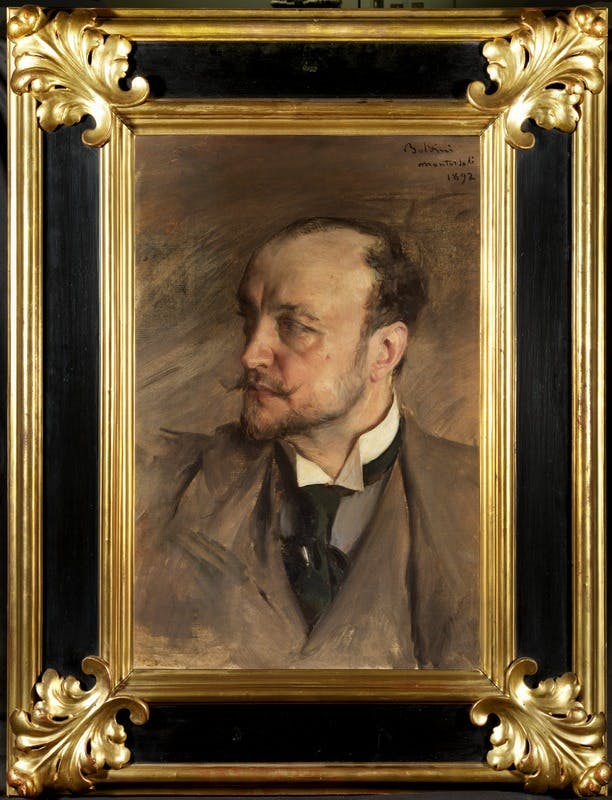
The eighth of thirteen siblings, Giovanni Boldini was born on December 31, 1842, in Ferrara and had a very Catholic upbringing as his mother, Benvenuta Caleffi, was quite devout. His father Antonio, on the other hand, was a painter. Even before he learned to read and write and began attending elementary school, Boldini showed a natural talent for drawing. He soon abandoned his studies, proving rather impatient with school rules and teaching methods, and his father, sensing his son’s abilities, directly taught him the basic techniques of painting. His father was a purist painter who possessed excellent technical fundamentals learned during his years at theAccademia di San Luca in Rome and through the study of the masters of the 15th century, however, becoming a well-known name in Ferrara. Giovanni Boldini, meanwhile, painted a Self-Portrait when he was only fourteen years old, which demonstrated not only how well the young painter had assimilated basic painting techniques, but above all his ability to master them with ease. Soon after, he became a pupil of Girolamo Domenichini and Giovanni Pagliarini. His adolescence was rather fortunate, as he was exempted from the military service that had just been instituted following the birth of the Kingdom of Italy, and in addition he obtained a substantial inheritance from an uncle. With this sum, Boldini decided to leave Ferrara, as he had noticed that there was a tendency among local artists to settle for equaling what other artists had already proposed, and it was very difficult to be able to pursue new paths. He therefore chose to move to Florence.
Once in the Tuscan capital, Boldini enrolled at the Academy of Fine Arts, where he found Stefano Ussi and Enrico Pollastrini as teachers. However, as had been the case during elementary school, Boldini soon proved impatient with the Academy’s methods and withdrew, preferring instead to throw himself headlong into the lively environment that gravitated around the Caffè Michielangiolo. Here, in fact, numerous artists and patriots would gather to discuss, often heatedly, artistic and political issues. Among them were the “Macchiaioli,” a group of artists also in open opposition to the rigidity of the Academy. The group of artists was so named because of their use of broad brushstrokes of pure colors, with which they painted landscapes that reproduced as closely as possible the real visual perception of the human eye. Boldini, once he came into contact with the Macchiaioli, including Giovanni Fattori, Telemaco Signorini and Silvestro Lega, became interested in the new techniques they explored, yet unlike them he preferred to concentrate on portraiture, a genre that had always been congenial to him. He thus began to produce portraits of numerous friends and fellow painters, creating for himself a dense network of contacts that helped him greatly in his work. In fact, he soon came into contact with numerous aristocratic personalities who gravitated to Florence, especially foreign nobles, who not only commissioned several well-paid works from him but also opened the doors of their private collections to him.
The most important association was certainly with the Falconer family, English nobles who lived in a villa near Pistoia. Boldini became the lover of Isabella Falconer, who precisely because of this frequentation commissioned numerous works from him, and in parallel cultivated a close friendship with her husband. The latter wanted him with him on a trip to Paris in 1867 to visit the Exposition Universelle, where Boldini was impressed by the works of Edgar Degas. The trip to Paris instilled a new urgency in Boldini: for although he considered Florence to be the pinnacle of artistic culture, as he went abroad he realized that there were other cultures to explore, and Italy began to grow more and more cramped for him. So he began to travel tirelessly aroundEurope, first to France with Isabella Falconer and then later to England, after accepting an invitation from the nobleman Cornwallis-West. Thanks to his protection, Boldini entered the circles of the English nobility, and here, too, he was in great demand for his skills as a portrait painter.
However, after a short time Boldini began to prefer Paris to London. France, at that time, was at the dawn of the Third Republic, and Paris in particular was taking on the contours of a modern, dynamic city full of cues, including literary cafes, museums, and clubs. Thus, Boldini moved there permanently in 1871. As a lover of social life, Boldini wanted to settle in the Montmartre district and began frequenting the Café de la Nouvelle Athènes, which was located just across the street from his home. This was where the artists who soon after would give birth to the Impressionist movement used to gather. While frequenting the Café, Boldini met and befriended Degas, the one who had impressed him at the Exposition Universelle.
During this same period, between 1871 and 1878, Boldini entered the circle of the art dealer Adolphe Goupil, who had gathered several innovative artists under his protection, including Giuseppe Palizzi and Giuseppe De Nittis. Thanks to this collaboration, Boldini not only achieved a certain economic stability, but he was welcomed into the most important exhibitions and became the leading artist in Parisian salons. Boldini, despite his strong ties to the French capital, never stopped traveling. He traveled to the Netherlands in 1876, where he came into contact with the painting of Frans Hals; in 1889 he traveled to Spain and Egypt with his friend Degas; and finally in 1897 he exhibited some works in New York. With the arrival of the 20th century, Boldini returned often to Italy to participate several times in the Venice Biennale and receive the honor of grand officer of the Order of the Crown of Italy. He died in Paris on January 11, 1931, and his remains lie, at his explicit request, in the monumental cemetery of the Certosa di Ferrara.
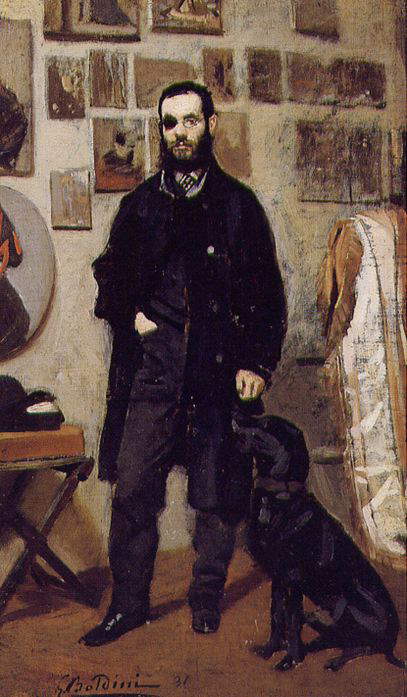
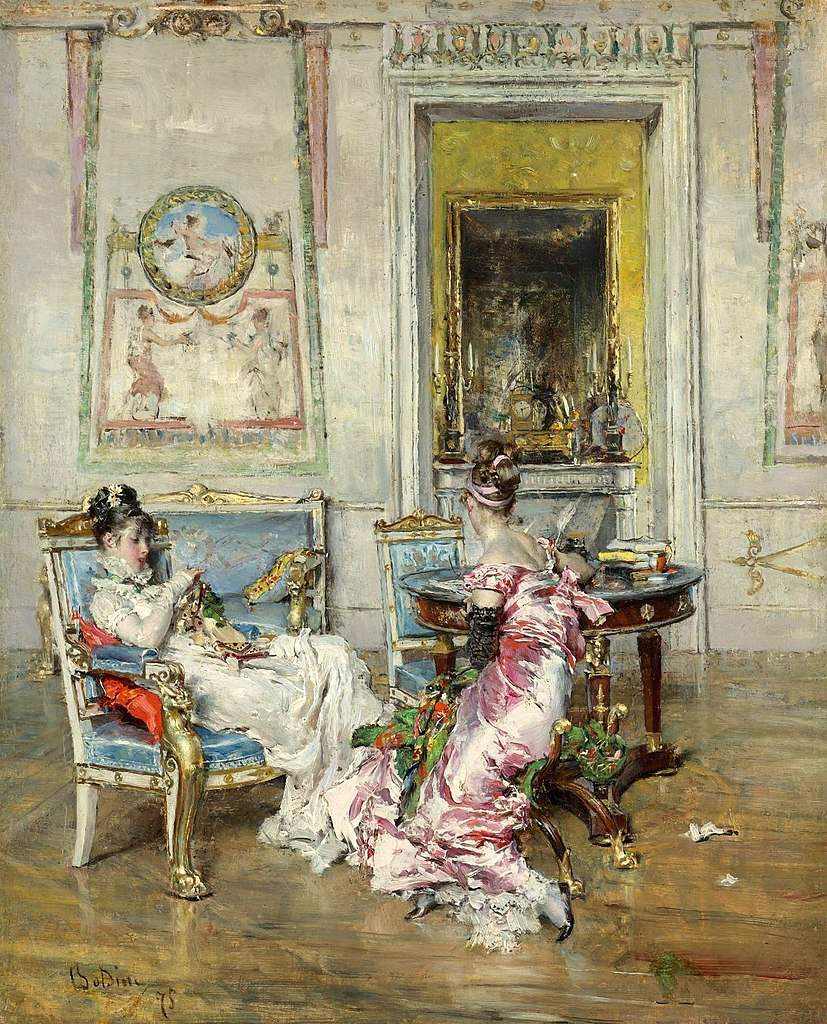
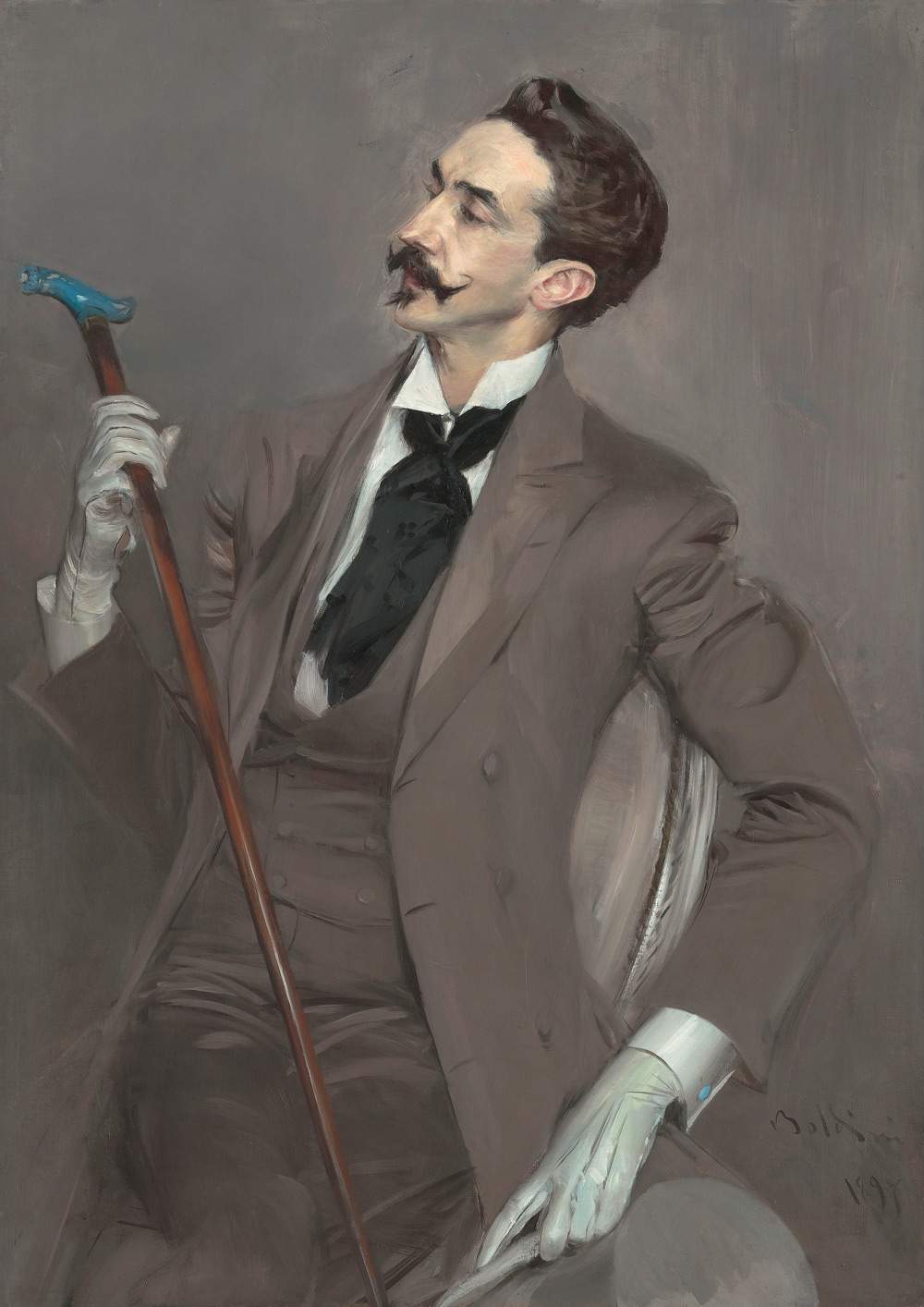
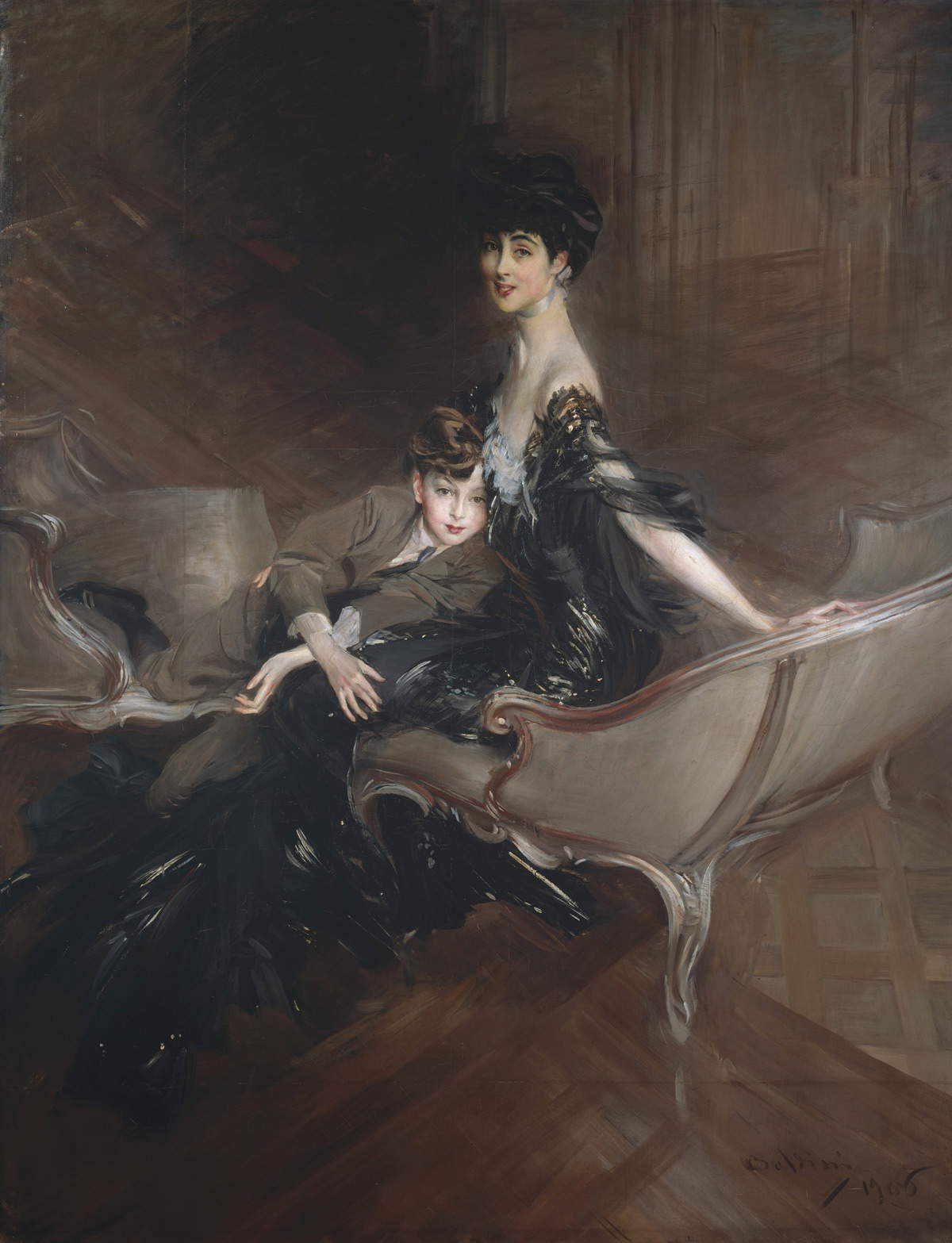
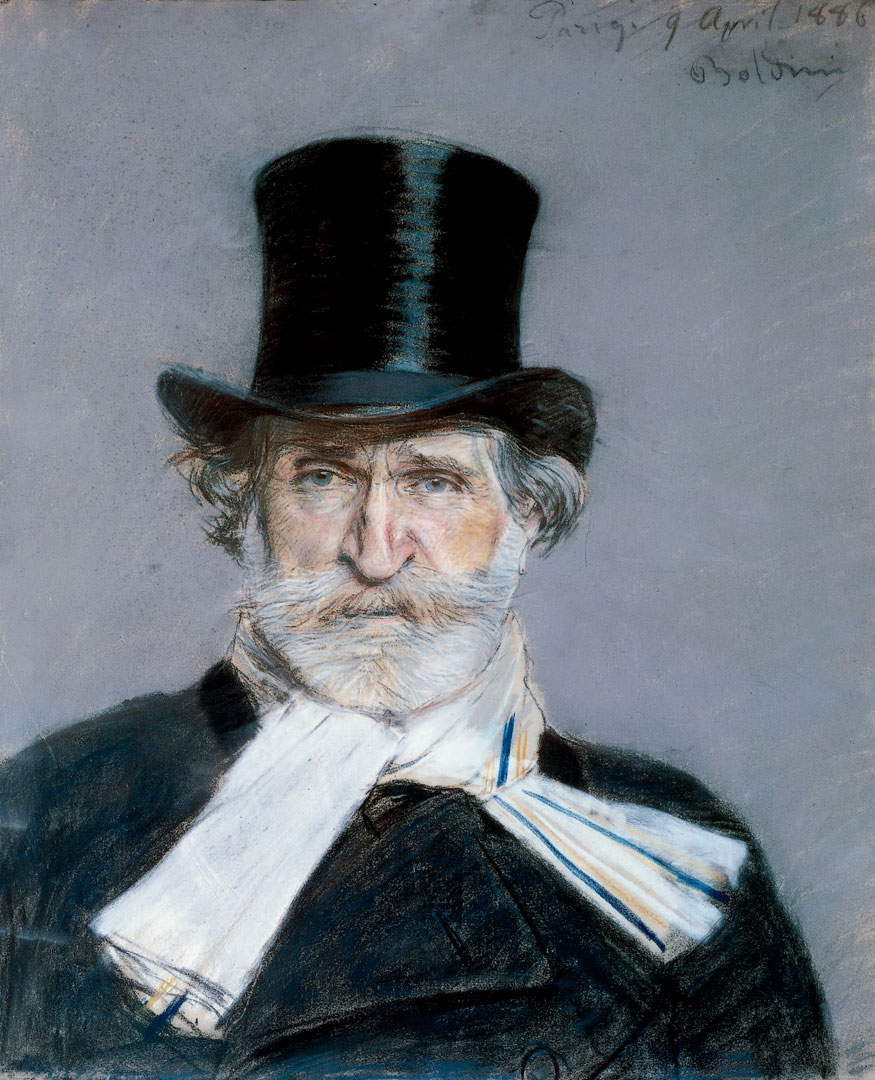
Trained through the study of works dating back to the 15th century that his father presented to him at classes, Giovanni Boldini further developed his art through contact with the Macchiaioli, without, however, fully adhering to their group. Compared to those of the Macchiaioli, in fact, Boldini’s paintings veer toward much bolder and more dynamic solutions of line and color. Moreover, Boldini clearly preferred portraits to landscape paintings. See for reference the Portrait of Giuseppe Abbati (1865), a painter Boldini frequented in Florence. He is not portrayed in a canonical pose, rather Boldini gives the idea that he captured the moment when his friend dropped by to visit him in his studio while he was nearby, walking his dog (also in the painting). The space around Abbati also turns out to be dynamic; it is even possible to see how some of the paintings hanging on the wall on the right side appear blurred.
Boldini’s tendency to prefer portraiture was also behind his departure from the Impressionists, whom he frequented in Paris. Certainly some of the influences of Edgar Degas and companions do indeed seem to have touched the painter’s imagination to some extent, and he painted not only portraits but also genre scenes in this period, see, for example, Le chiacchiere of 1873, or Lo strillone parigino (the Parisian newsboy) of 1878. Also singular are some paintings that refer to the period when Boldini worked at Goupil’s: indeed, the art dealer asked his artists to please the taste of his clients, who liked to surround themselves with works that echoed 18th-century French painting. Works from this period denote changes in style in Boldini’s production, especially in the color palette, which became lighter and more ethereal. An example of this is Dames of the First Empire (1875).
But as soon as his collaboration with Goupil ended, Boldini explored darker hues, turning to shades of red, brown, and black. Very important in this exploration were the admittedly very intense and dark colors in the works of Frans Hals and Diego Velázquez.
Boldini executed portraits of many important personalities of the time, including the writer Robert de Montesquiou (1897), Duchess Consuelo Vanderbilt (1906), but especially Giuseppe Verdi (1886). The portrait of the famous composer was not an easy task, in fact what we know is the second version of the opera. The first version did not convince either Boldini or Verdi, for several reasons including Boldini’s difficulty in portraying a restless Verdi who was constantly in conversation with his assistant, so the painter faced with the situation asked Verdi to give him a second chance. The result was the version that went down in history and became the de facto official image of Verdi, who was very impressed.
The power of Verdi’s portrait is certainly given by the expressiveness of the face and the judicious choice of details, from the top hat representing the composer’s high economic status to the scarf symbolizing instead his artistic flair. Although the subject is taken in a half-length shot and framed in a flat, gray background without any elements, the depiction is by no means static but. as in the tradition of Boldini’s portraits, there is a certain dynamism. We find it either in the position in which Verdi is portrayed, slightly to the side, or in the pastel stroke, which Boldini skillfully uses so as to blur some details and emphasize others, but it is especially evident in the face of the protagonist. Caught in a very particular expression as if he were about to speak, Verdi’s eyes are vivid and capture the gaze of the viewer of the painting.
Returning to Boldini’s artistic production, it is evident that the absolute protagonists of his portraits were bourgeois women, depicted at their most feminine and full of personality. Long, vertical or sinuous brushstrokes outline decidedly ethereal figures, wearing clothes that seem to move and twirl lightly in space. The setting of these portraits is almost always the same, namely an indoor room with a sofa or a bed on which the protagonists are sitting or leaning. The faces, which are entrusted with the focal point of the canvas, are enhanced by decisive, well-delineated features, and reveal a wide range of emotions, from fragility to mischievousness, from resoluteness to wit, thus giving the woman a “speaking” role, with a unique and autonomous voice.
In depicting women, Boldini focuses on certain recurring details, such as the neck, back, elegant profile, bare shoulders and daring necklines, or the elegance of the dress when it is closed at the neck or complemented by a showy hat. Some of Boldini’s finest female portraits include Portrait of Princess Marthe-Lucile Bibesco (1911), Marchesa Luisa Casati with Peacock Feathers (1913) and The Woman in Pink (1916).
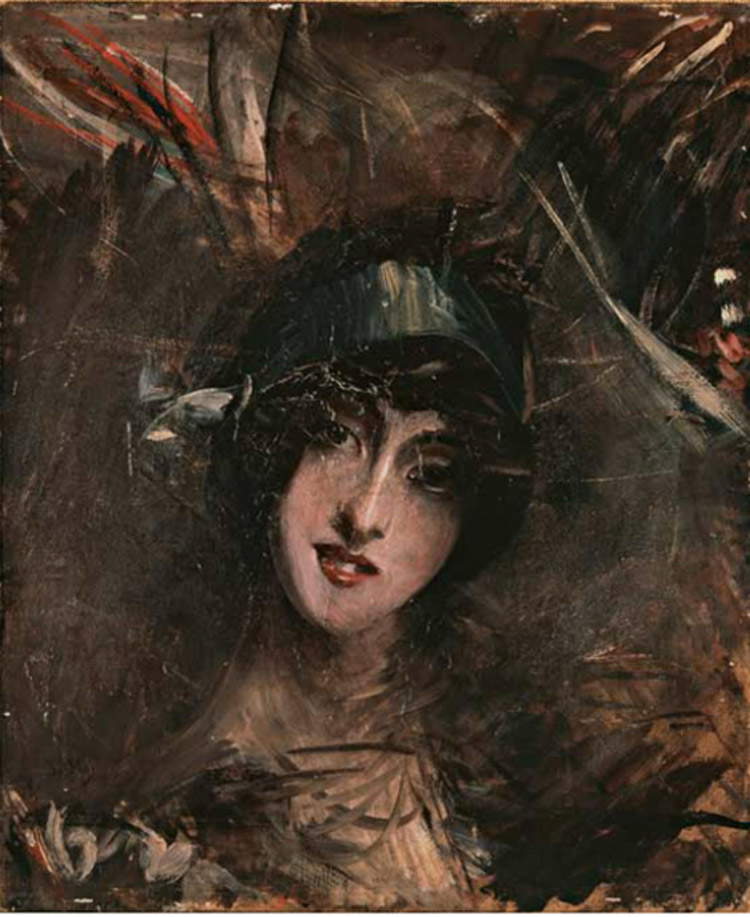
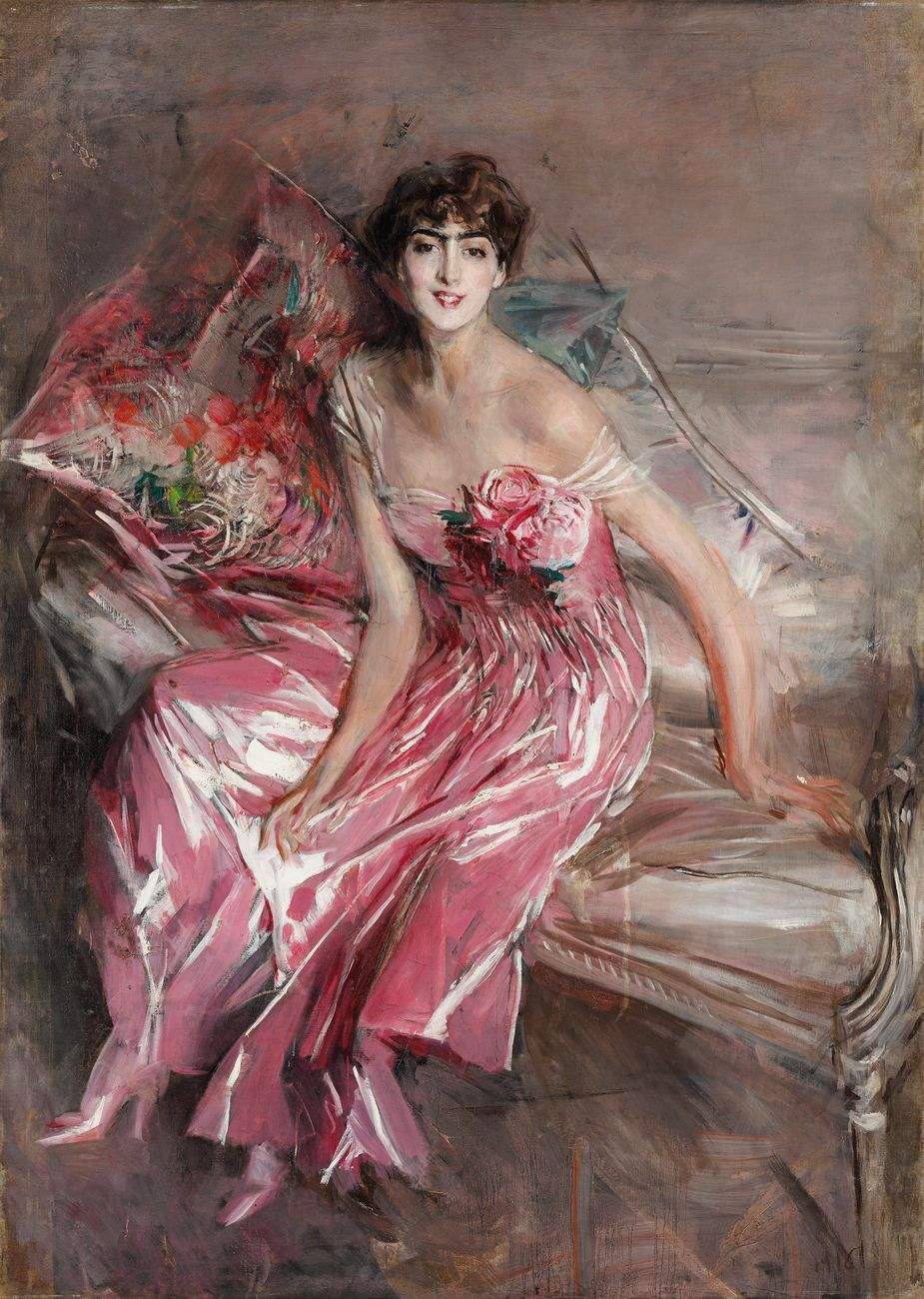
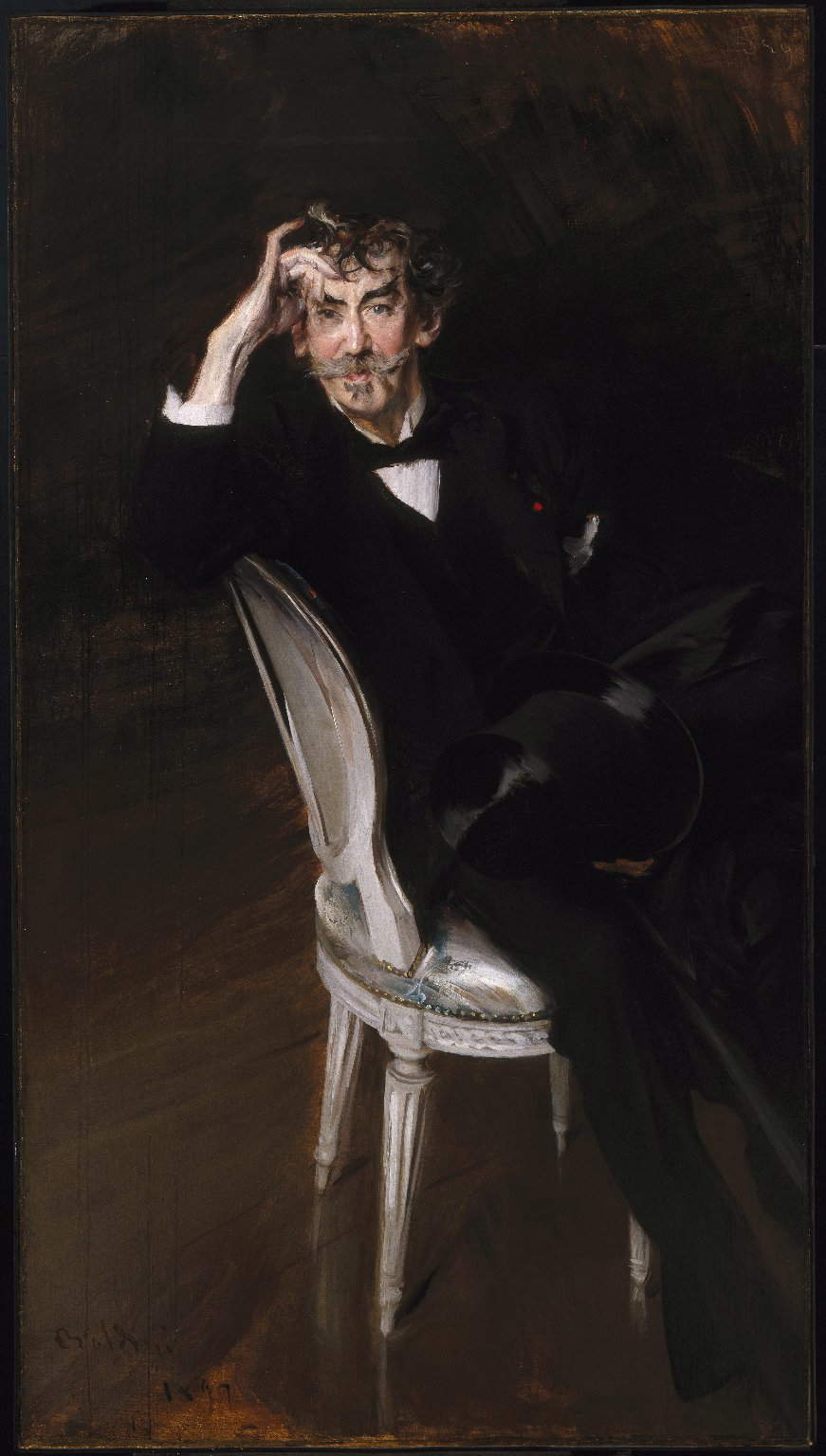
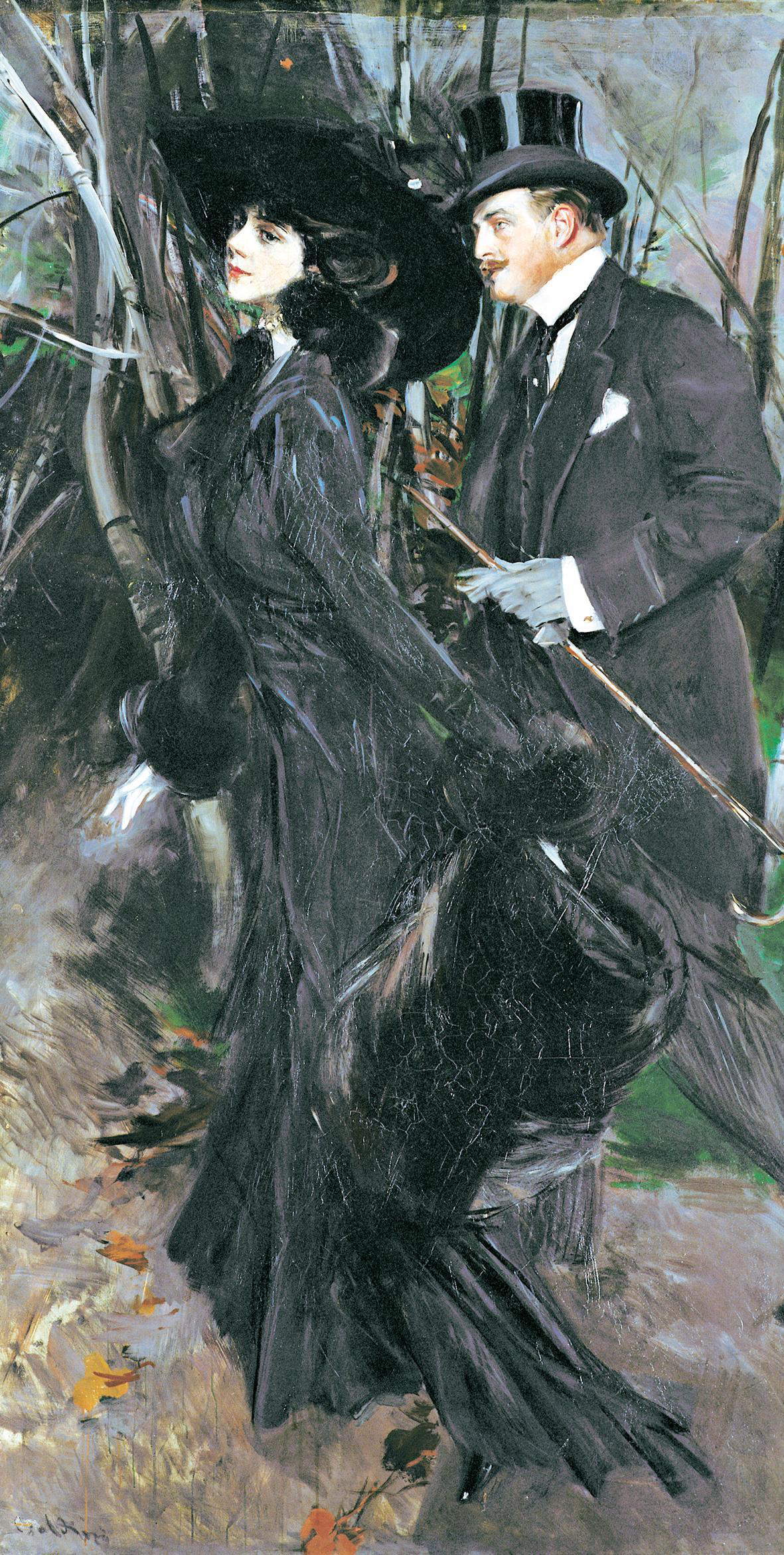
In Ferrara, Boldini’s hometown, a museum dedicated specifically to the memory and works of Giovanni Boldini was established in 1936. Here it is possible to see, among others Two White Horses (1874) The Walk at the Bois (1909) and Woman in Pink (1916), as well as numerous drawings and watercolors. In Italy we find other works by Boldini present in renowned museums such as Self-Portrait While Observing a Painting (1865) and Portrait of Diego Martelli (1865) in Florence at the Galleria d’modern art at Palazzo Pitti, The Parisian Screamer (1878) at the Capodimonte Museum in Naples, the Portrait of Giuseppe Verdi (1886) and Marchesa Luisa Casati with Peacock Feathers (1913) at the National Gallery of Modern Art in Rome (the first version of Verdi’s portrait is, however, in the Musicians’ Rest Home in Milan), a Self-Portrait (1892) at the Uffizi Gallery in Florence. Numerous paintings are part of private collections.
In Europe, and especially in France where Boldini lived for a long time, the Portrait of Madame Charles Max (1896) and the Portrait of Robert de Montesquiou (1897) at the Musée d’Orsay are preserved. Some paintings can be found in the United States of America, specifically in New York, such as The Parisians (1873), Ladies of the First Empire (1875), The Dispatcher (1879), at the Metropolitan Museum, while Portrait of James Mcneill Whistler (1897), Portrait of a Lady (1912) are in the Brooklyn Museum.
 |
| Giovanni Boldini, life and works of the great Ferrara artist |
Warning: the translation into English of the original Italian article was created using automatic tools. We undertake to review all articles, but we do not guarantee the total absence of inaccuracies in the translation due to the program. You can find the original by clicking on the ITA button. If you find any mistake,please contact us.